

Lower-cost options for avoiding the WATE
The Sony a7R is receiving plenty of well-deserved attention since its announcement in mid-October. As prototypes appeared in selected hands (such as Michael Reichmann’s), “first-impression” style reviews quickly followed (e.g., Sony Alpha 7R Hands On right here at the Luminous-Landscape). Production cameras were released in November, and dozens, if not hundreds, of reviews have been published on-line and in print. User reports have proliferated on various photography forums–-perhaps the most extensive collection is the 157 pages (and counting) on Fred Miranda’s alternative gear forum.
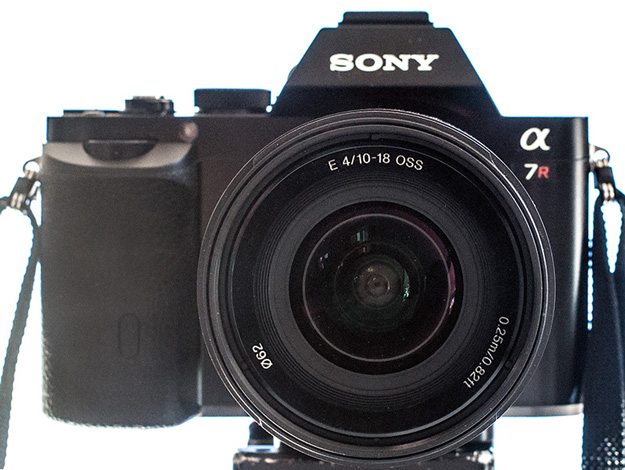
Sony a7R and Sony 10-18mm f/4
Now that photographers have had the Sony a7R to use for a few weeks, rather than merely to test briefly, more articles about real-world utility are available. For example, Michael wrote about his experience with seven Leica M lenses on the a7R in The World’s Best Sensor Meets the World’s Finest Lenses. One of the big advantages of the Sony E-mount’s short focal-plane-to-flange distance is the opportunity to mount just about any ol’ lens via an adapter. In the absence of a native Sony / Zeiss lens wider than the 35mm or 28-70mm FE lenses at the close of 2013, a7R owners immediately began searching for adaptable wide lenses of other makes. Based on experience with wide-angle lenses and the Sony NEX-7 sensor (e.g., Michael’s A Sony NEX-7 Rolling Review and my Some Wide Angle Options for the Sony NEX Cameras), there was widespread concern that the new Sony full-frame sensors might not work well with compact symmetrical-design wide-angle lenses. So, there has been much speculation and observation reported on the net about which wide-angles would or in fact, actually did work adequately on the a7R. I’ve been fortunate to own a variety of lenses that get used on a Sony NEX-7 and other cameras. Once the a7R arrived, the lens collection was put into action via adapters on the new camera. After about three weeks of experimenting with various optics, this report briefly summarizes one photographer’s results from an eclectic mix of wide-angle lenses on the Sony a7R.
Early conjectures suggested that the optimum wide-angle lens for the a7R might be the Leica Wide Angle Tri-Elmar 16-18-21mm f/4 ASPH lens, often called the WATE in Leica-speak. And, indeed, a few reports on the net say that they make a pretty good pair. The WATE was among those lenses that Michael tested in The World’s Best Sensor Meets the World’s Finest Lenses. The sterling reputation of this lens seems well deserved, by all accounts. Sadly, it is seriously expensive. Nevertheless, we’ll consider it as the “gold standard” for comparison purposes here, and I set about to find out how some other lenses might measure up until the optical engineers at Sony and Zeiss design and produce a really wide lens optimized for the a7R sensor and its presumed successors. In the process, I got carried away and looked at several lenses in the 20-30mm range as well. Many of these lenses were tried simply because I had access to them, not because they had much potential or otherwise seemed like a good idea – just curiosity run amok. Almost all early reports suggest that the Sony FE 35mm lens is a winner, so this report won’t mention lenses longer than 30mm.
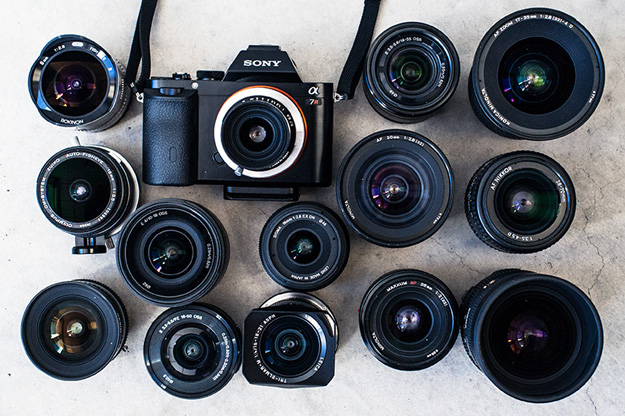
There are plenty of possibilities to adapt to the E-mount.
Avoiding the Brick Wall when Testing Lenses
Although I must admit to photographing an Edmunds USAF resolution chart posted in our garage and the office book case and our cat for semi-consistent subject matter to compare lenses, most of my evaluation was based on real-world subjects. My favorite category for this sort of thing is the Jeffrey and pinyon pines in my neighborhood in the eastern Sierra Nevada of California. The trees are right outside, and their needles provide ample fine detail for evaluating image quality. In addition to the local natural landscape, there are plenty of opportunities for comparative imaging in the supermarket, post office, locker room of the ski area, etc. Examination of magnified images on screen allows one to quickly weed out those lenses without much potential, but after that first cut, I like to compare prints from the better lenses as a more real-life evaluation. Although the printing does burn up some ink in a possibly wasteful manner, it is a great way to check out new papers or get rid of the stock of papers I don’t otherwise use any more. In this article, I will generally use “sharpness” and “softness” as generic vague terms to describe whether fine details are clear and distinct or not. In the real world of prints, many other factors contribute to whether an image looks good or not, but all such perceptions are quite subjective and exceedingly difficult to describe. And I certainly won’t touch the artistic merits.

Supermarket aisles provide many opportunities for lens testing.
a7R with Sony 10-18mm lens at 16mm, ISO 1250 f/6.3 1/40 PS-transform
Because most of the lenses that one might consider for the a7R are probably at least half-decent (otherwise, why would they still be in your collection?), testing comes down to looking for flaws. And any flaws will mostly likely appear on the edges and in the corners. Virtually all the lenses I tried on the a7R were remarkably sharp in the center. So, when looking for problems, I often use subject matter with fine detail in at least one corner. Besides the local pine needles, newspapers taped to a wall and a row of stacked magazines (a bookcase full of National Geographics would be handy for this task) allow some quantification of how close to the edge the image starts to get soft.
Leica Wide Angle Tri-Elmar 16-18-21mm f/4 ASPH
The WATE really is a fine lens. Period. And, it seems to get along well with the Sony a7R. The images I’ve taken so far with the combo have been as good as I could hope for, my own artistic and technical lapses notwithstanding. However, as Michael mentioned in his recent article about Leica M lenses and the a7R, “all is not perfect in Sony a7R land”. Vignetting, some magenta or purple color cast along the edges, and some softness or detail-smearing in the corners can be found if you look for problems. The corner issues are most pronounced and identifiable if you photograph a uniformly-lit white wall or translucent sheet of plastic or an ExpoDisc, which I excavated from a stash of forgotten gear. Incidentally, these whitish images are useful if you want to fix such problems from any of the lenses discussed here via Adobe’s DNG Flat Field Plug-In or Cornerfix. With many subjects, the corner issues appear insignificant and may not require any additional processing. The WATE truly shines relative to other wide-angle lenses with respect to minimizing distortion. Certainly, there is some, but it looks rather minimal when compared with other wide-angles. Also, the WATE seems to be an appropriate size (2.4 inches long) and mass (12 oz) for the a7R.
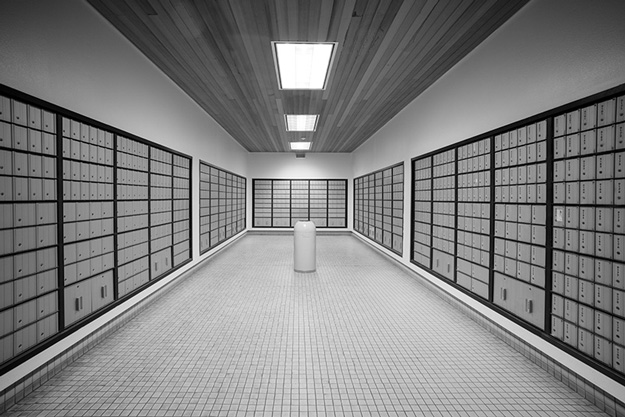
The WATE is particularly good for architectural subjects with lots of detail.
a7R with WATE at 18mm, ISO 200 f/11 0.8s +
Rokinon 8mm f/3.5 fisheye
This small fisheye lens intended for the Sony NEX series had seemed quite sharp on the APS-C sensors, so I was curious to see what it could do on the a7R. Well, it produces those pesky fisheye images and doesn’t cover a very big image circle – actually a quasi-rectangle. However, if you need an extraordinarily wide field of view and want to play with a de-fishing program and/or transform-warp in Photoshop, this option has a very low admission fee. It is probably best to use the a7R’s APS-C crop mode with this lens. It can produce good close-up scenes where an extended depth-of-field is important.
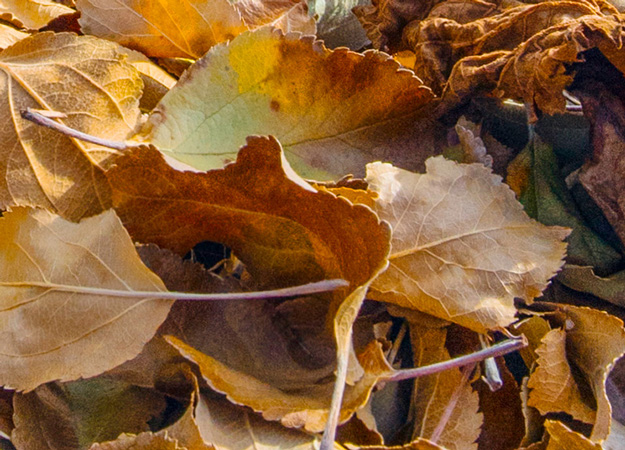
With enough cropping (here only 10 percent of the total image), images from a fisheye lens can offer a normal perspective.
a7R with Rokinon 8mm f/3.5, ISO 400 f/11 1/320
Sigma 8-16mm f/4.5-5.6 DC HSM
This ultra-wide Sigma zoom is a big lens intended for Alpha-mount cameras with APS-C sensors, such as the Sony a77. However, I had used it occasionally on an a900 with adequate coverage and excellent sharpness. So, with the lens on the Sony LA-EA4 adapter, I gave it a try on the a7R. A substantial amount of physical vignetting is present from 8mm through 12mm, then the corners are fairly dark from 13mm through 15mm, but it seems to be a very fine 16mm lens on the a7R. Although limited to a single focal length for full coverage, the Sigma 8-16mm lens is probably similar to the Sony 16-35mm and Nikon 14-24mm (neither personally tested) by being capable of excellent results on the a7R but completely out of proportion to the size and weight of the camera.
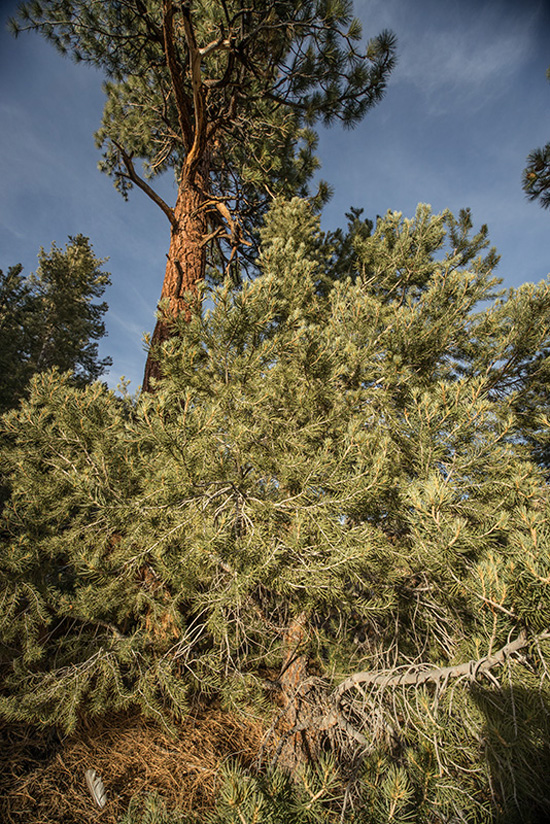
The Sigma 8-16mm lens dwarfs the a7R, but provides quality images.
a7R with Sigma 8-16mm at 16mm, ISO 400 f/11 1/200
Sony 10-18mm f/4
Almost as soon as the a7R was announced in October, there was speculation on the internet about whether Sony’s wide-angle zoom for the NEX cameras might have any potential on the full-frame cameras. In the past month since the a7 and a7R have actually been available, reports about compatibility have ranged from “awful, rubbish, ugly”, etc. to “almost as good as the Nikon 14-24”. Take your pick. Because I have had great results from the 10-18mm lens on the NEX-7, I suspect that most of the negative comments came from people without direct experience or had a bad copy of the lens. Mark Segal wrote a thorough Sony 10-18mm f/4 E Lens Review here in November 2012.
Since the arrival of my a7R, the Sony 10-18mm lens has been used more than any other lens. Bottom line: it works remarkably well at 15 and 16mmmost of the time. That caveat is why it has spent so much time on the camera. I’m still trying to figure out the somewhat inconsistent performance. Unless you want to crop away some edge and corner areas, the lens really only covers the full frame at 15-16mm. But, at that optimum focal length and at f/8, the lens produces great imagesmost of the time, rivaling the WATE at 16mm in terms of sharpness right out to the far corners. However, in about 10-20 percent of the cases, the far corners show some softness and smearing of details. My initial suspicions are that the inconsistencies relate to subject matter and depth of field – subjects that are a fairly uniform distance from the camera tend to have the best corners and scenes with a great near-far separation tend to show some corner smear. Also, most of the time, the Sony 10-18mm lens demonstrates considerably more distortion than the WATE. However, when I’ve been careful (or lucky) to get the camera properly aligned and squared up, distortion of man-made subjects is minimal. Distortion of natural objects is not necessarily much of an issue, depending on your artistic and documentary philosophy.
At focal lengths other than 15-16mm, the zoom lens exhibits all the usual problems with very wide angle lenses on a demanding sensor. At 10mm, there is a large oval black-out vignette. At 12mm and 14mm, vignetting lessens, but there is a magenta color cast toward the edges and corners and some smearing of outer-edge details. Strangely, vignetting returns when the lens is zoomed to 17mm and 18mm. So, a 15/16mm lens it is.
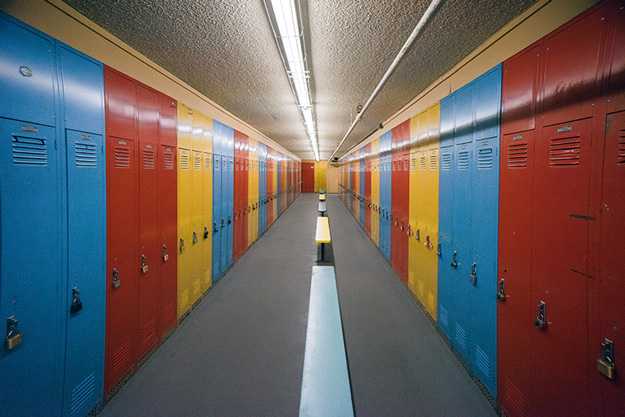
The Sony 10-18 can work for interiors as well as landscapes.
a7R with Sony 10-18mm at 16mm, ISO 5000 f/6.3 1/125
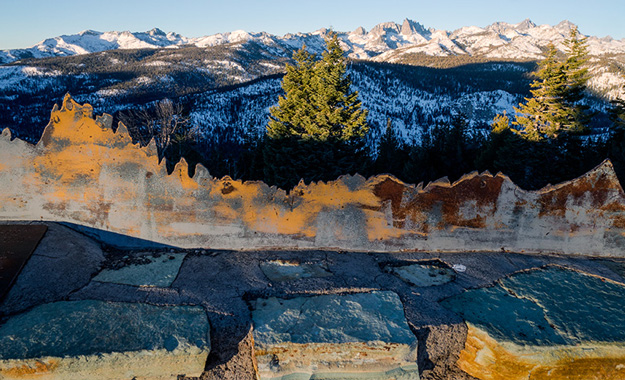
When maximum depth of field is important, the 10-18 can be used at the wide end, followed by significant cropping.
a7R with Sony 10-18mm at 11mm, ISO 200 f/20 1/25
Olympus Zuiko 16mm f/3.5 fisheye
This lens was the big surprise of this evaluation – if you can ignore or work around the distortion, this elderly Olympus fisheye lens proved to be a close rival to the WATE in terms of sharpness in the central region of the image. Apparent sharpness at the edges of the undisturbed images is also excellent, but most images from this lens will probably be de-fished or warped to some extent, and then, fine detail around the edges ain’t what it started out to be. Like many lenses of its age, the Olympus Zuiko 16mm seems to be at its best at f/8 and f/11. If you need a really wide field of view and can deal with the fisheye curvature, this Olympus 16mm is a fine match for the a7R.
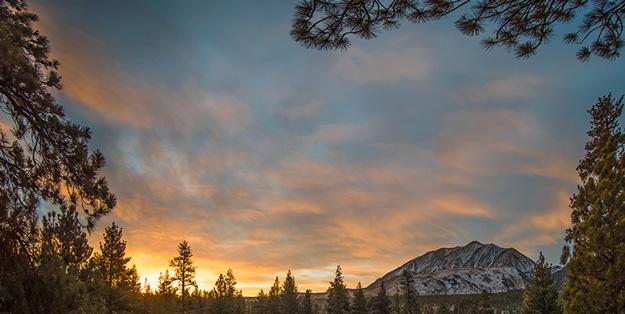
The Olympus Zuiko 16mm proved to be one of the best super-wides of this evaluation.
a7R with Olympus 16mm, ISO 50 f/11 1/13

What’s a lens test without a cat picture? The detail when pixel-peeping images from the Olympus 16mm was amazing.
a7R with Olympus 16mm, ISO 3200 f/8 1/60
Sony 16mm f/2.8
This tiny lens is not the total dud it is often made out to be – how’s that for high praise? Although my copy does not seem to render details at and near infinity very well, the lens does surprisingly well on the a7R in the 5 to 20 feet range for the central half of the image circle – more high praise! So, if you need the absolutely smallest, lightest a7R rig for wide fields of view at moderate distances and can crop away the outer portions of the image, the little 16mm might work for you. Otherwise, just use it (assuming you have one of the better copies to begin with) on a NEX-5n.
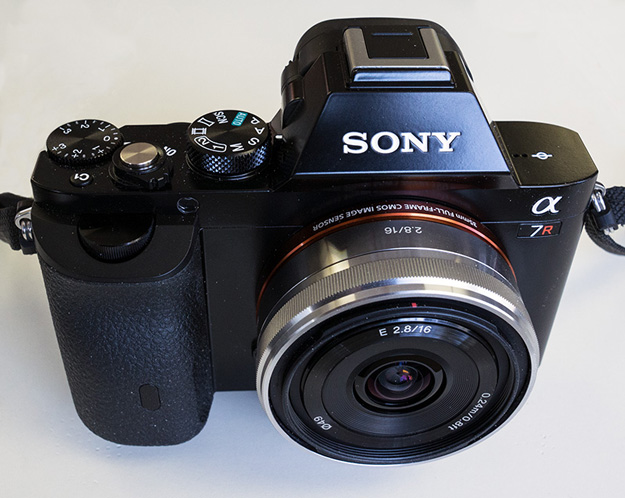
The Sony 16mm makes the smallest a7R package possible, but is it useful?
Sigma 19mm f/2.8 and 30mm f/2.8
These lenses would be superb on the a7R if only they covered the whole sensor. Instead, you get an oval image that cuts off a couple of millimeters from the long side and a lot off the corners. However, inside of the black mask, there is remarkably little fall-off of image quality as the outer limits of the image circle are approached. One could extract an excellent-quality wider-than-APS-C 2:1 (something like 26x13mm) crop out of the entire frame. I’ve admired both of these lenses on the NEX-7, and their image quality holds up on the a7R, the substantial vignetting notwithstanding. Except for the extreme edges of the image circle, the quality was right up there with the WATE. Both of the Sigma E-mount lenses mentioned here are the older version. The current DN lenses may have different characteristics.
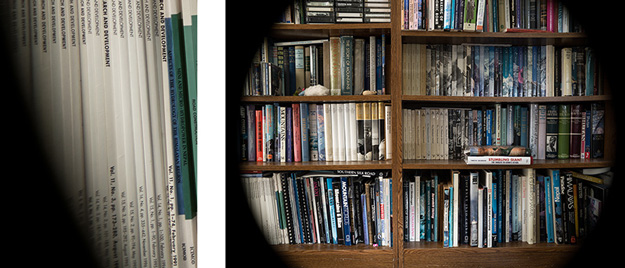
Both E-mount Sigma lenses have a small image circle for full-frame, but the image
remains sharp very close to the edge, as illustrated in the crop from the lower left corner.
a7R with Sigma 30mm, ISO 50 f/11 4s
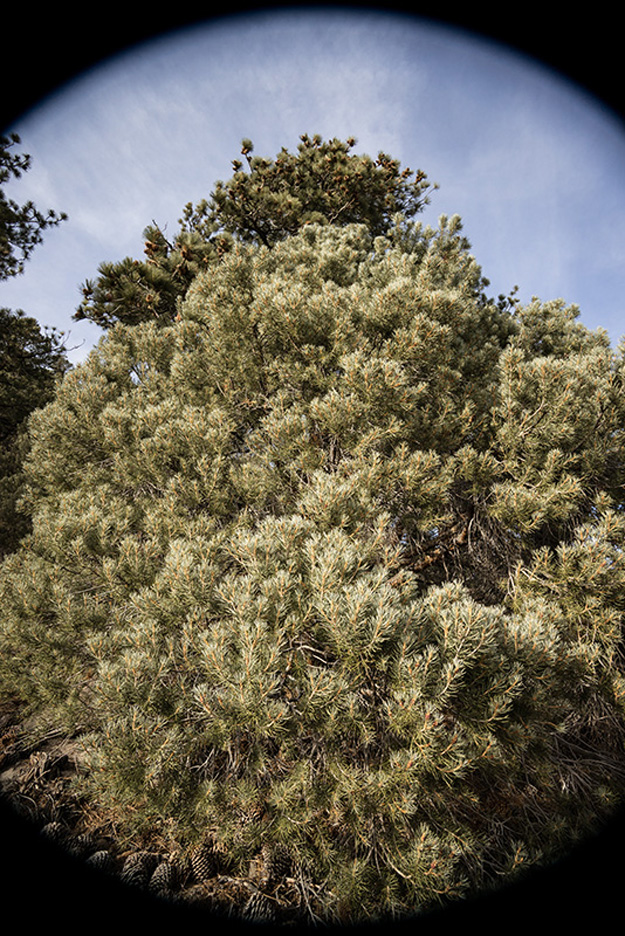
The vignetted full-frame image from the Sigma 19mm lens still offers a reasonable area from which to crop.
a7R with Sigma 19mm, ISO 400 f/11 1/200
Nikon 20mm f/2.8 AF-D
This lens was easily the best performer out of the three retrofocus SLR 20mm lenses I had available (this one, a Nikon f/2.8 Ais, and a Minolta Maxxum f/2.8). Although all three lenses demonstrated excellent center sharpness, this auto-focus D series lens produced test images with significantly better corners. With the AF-D lens, corners were “OK” at f/4 (center sharpness was only OK at f/4, as well), corners looked better at f/5.6, and could be considered “excellent” at f/8 and f/11. Image quality then began to fade at smaller apertures. Overall, the AF-D lens was not quite up to the WATE standard, but it was still capable of results that would satisfy most viewers. The manual-focus Nikon 20mm f/2.8 Ais produced fine results at f/11 only. Another similar lens that I have not tried, but has had a few positive reviews for use on the a7R is the Canon FD 20mm f/2.8.
Olympus Zuiko 24mm f/2.8
I received a copy of this semi-legendary lens late in this comparison process. This particular copy seems to live up to the generally high marks found on the net. Based on considerably less testing than most other lenses evaluated here, the Olympus 24mm f/2.8 appears to be an excellent match for the a7R. Like almost all lenses tried on the a7R over the past three weeks, center sharpness was excellent. However, the corners and edges of images from this 24mm lens looked far better than the competition. Based on ExpoDisc tests, vignetting is obvious at f/5.6 and wider, slight at f/8, and just about gone at f/11. In outdoor images, corner smearing and color cast were not apparent at f/8 and f/11. Overall, this lens may be slightly better than the Olympus 28mm f/2.8, and it captures a bit more of the world. If the field of view of a 24mm is sufficient for your wide-angle needs on the a7R, then this lens may be a fine choice.
Voigtlander Color Skopar 25mm f/4
I had high hopes for this little lens based on my experience with it on a NEX-5n and NEX-7. Alas, this pairing with the a7R suffers from a fairly bad case of the corner problems. The magenta color cast is quite obvious. Its optimum use on a Sony a7R would seem to be for black and white prints.
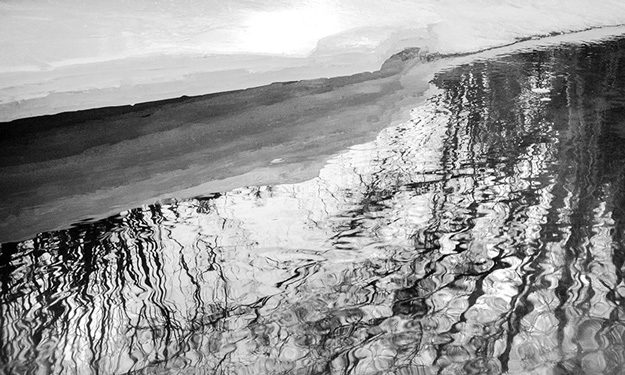
The Voigtlander 25mm has serious corner issues on the a7R, but it can still yield good black and white prints.
a7R with Voigtlander 25mm, ISO 320 f/8 1/50
Minolta Maxxum 28mm f/2
Based on the superb results of the Minolta Maxxum 35mm f/2 on the A900, I found a copy of the 28mm sibling a couple of years ago. While the 28mm seemed OK, it failed to live up to the high standard of the 35mm f/2. Nevertheless, I held on to it and had it available when the LA-EA4 adapter for the a7R arrived. Although it has minimal vignetting or color cast issues, the corners are a bit soft on the a7R. The Minolta Maxxum 28 f/2 on the LA-EA4 is much bigger and heavier than the following two 28mm options, but it auto-focuses and it produces better overall results at wider apertures (e.g., f/4) than the older 28mm lenses described below.
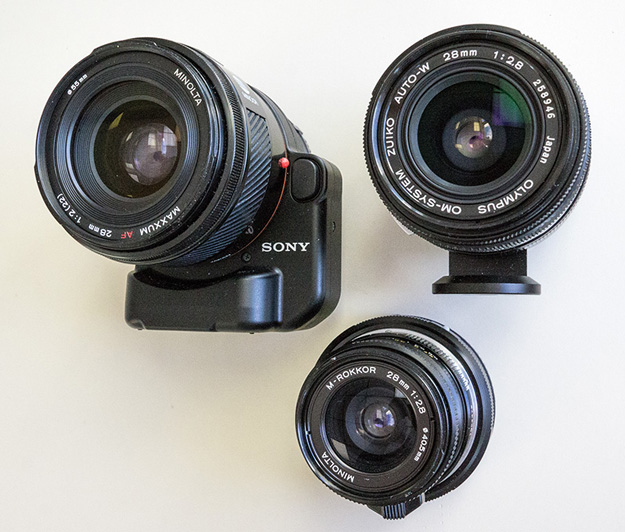
Three different 28mm lenses were tried, and all yielded fine images.
Minolta M-Rokkor 28mm f/2.8
Minolta and Leica had a collaboration or partnership or some sort of arrangement in the 1970s and 1980s that produced a variety of lenses and the Leica CL and Minolta CLE M-mount cameras. Three very small M-mount lenses were sold under the Minolta brand: 28mm f/2.8, 40mm f/2, and 90mm f/4. This trio seems well matched to the small and light concept of the a7R. The wide angle of this set fell within the confines of this evaluation and received a lot of use. Stopped down to f/8 or f/11, it yielded excellent images. At wider apertures, the edges and corners were soft. Many, if not most, of these 28mm M-Rokkors suffer from the dreaded white spot disease in which white spots grow inside of the front element and apparently degrade image quality. Be aware of that issue if you are seeking one of these lenses.
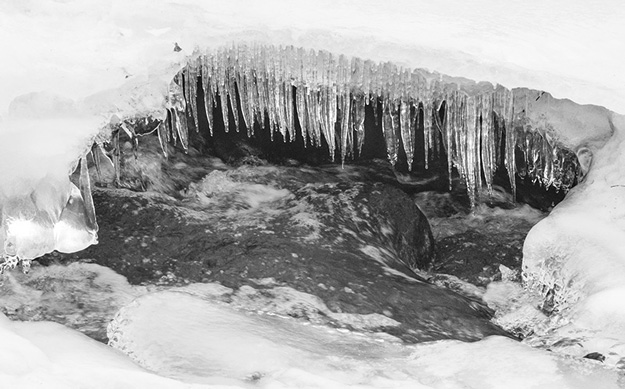
The 28mm M-Rokkor is a great match for the small size and weight of the a7R.
a7R with Minolta M-Rokkor 28mm, ISO 2000 f/8 1/100, heavily cropped
Olympus Zuiko 28mm f/2.8
Olympus made three variants of a 28mm focal length lens for their OM cameras: lenses with maximum apertures of f/2, f/2.8, and f/3.5. All three have their cheerleaders, and there is probably enough sample variation to account for some really fine examples of each type of 28mm. By chance, I happened to have a f/2.8 lens, and, fortunately, it seems to be one of the better ones. This copy performed great on the a7R at f/8 and f/11. Results from the M-Rokkor and the Olympus were quite similar, and I have not developed a preference for either lens over the other.
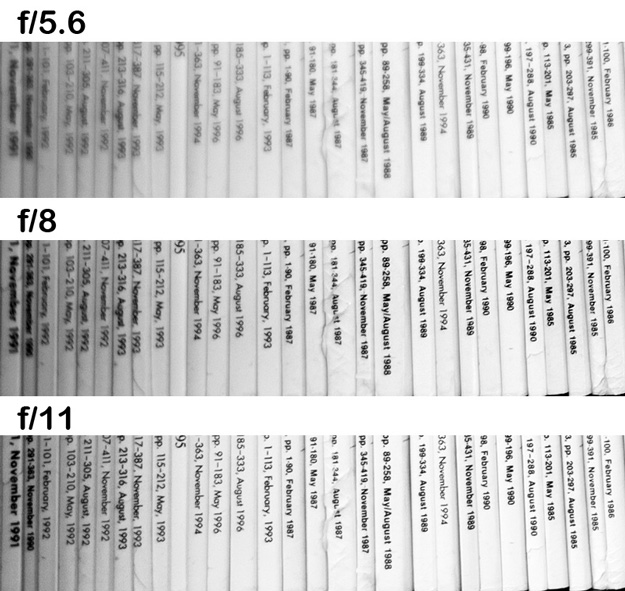
Crops from the lower left corner of a typical bookcase test image illustrate the relative
degradation of the image at three apertures with respect to distance from the edge of the image.
The complete scene is about 800 pixels across or about 11 percent of the total image length.
a7R with Olympus Zuiko 28mm f/2.8, ISO 50 from 2.5 to 10 seconds
Sony FE 28-70mm f3.5-5.6 OSS
Late in the game, a Sony FE 28-70mm lens (the one included as a kit lens for the 24MP a7 camera) became available for a quick-and-dirty evaluation. My initial impressions at the wide end were fairly negative. Barrel distortion was about as pronounced as I’ve witnessed outside of a fisheye; however, in-camera jpeg processing apparently corrects for the distortion (although I didn’t get around to trying it). Vignetting was also present at apertures wider than f/8. Corners didn’t look too good except at f/11. Overall, fine detail was just not as distinct with this lens as it is with the 24 and 28mm lenses mentioned above. On the positive side, there was not any dramatic color cast. However, after a little more time and more careful technique, the images from this lens appeared better than my first impressions. These differences provide another illustration of how sensitive the a7R is to at-least-adequate technique. Even though the FE 28-70mm lens has Sony’s Optical Steady Shot stabilization technology and seems appropriate for casual handheld use, the a7R doesn’t reward sloppy shooting. With this lens, image quality improved dramatically when used on a heavy tripod, at f/11, OSS off, avoiding the potential shutter-shake speeds between 1s and 1/100, and manual focusing. Of course, this lens offers a lot of versatility with the zoom range and the OSS, but it won’t take full advantage of the a7R’s capabilities in terms of image quality.
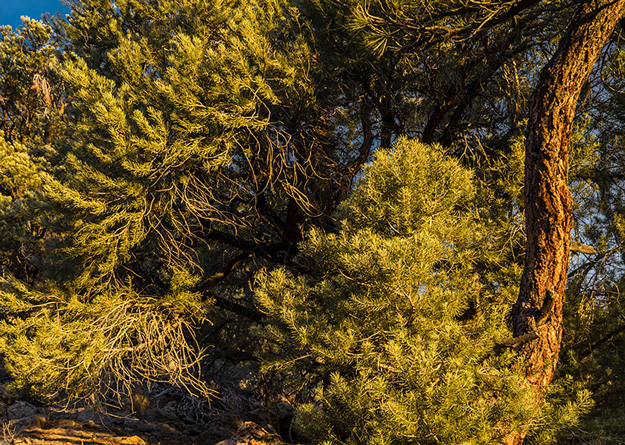
The zoom lens from the Sony a7 kit, while not ideal for the a7R,
is certainly convenient and is capable of decent results if not pushed too far.
a7R with Sony FE 28-70mm at 28mm, ISO 50 f/13 1/3, cropped
Sony Vario-Tessar T* FE 24-70mm f/4 ZA OSS
Very recently, I obtained Sony’s second mid-range zoom offering, the 24-70mm. My initial impressions are that it works much better on the a7R than the 28-70. Most reports on the internet during February and early March agree that it is an excellent 35-70mm zoom lens. My first tests support that conclusion, but I’ll keep to the wide side of the lens here. At 24-30mm, the center sharpness was excellent from f/5.6 through f/11. At those wide focal lengths, the corners and edges were a bit soft, though not obviously bad. In comparison, corners and edges at f/11 were better on the Olympus Zuiko 24mm and 28mm f/2.8 or M-Rokkor 28mm lenses than at the same focal lengths on this zoom. However, overall image quality, including corners, at f/4 or f/4.5 was much better with this zoom than with the “legacy” prime lenses. I have not noticed pronounced color cast or smearing (as opposed to softness) at the corners at the wide end of the zoom. Distortion is minimal compared to the 28-70mm lens. Some internet reports suggest that there is quite a bit of sample variation, including a rumored recall of a whole shipment prior to distribution. So, this lens seems to be one of those that requires some selectivity for your keeper copy. My first copy out of the delivery lottery is definitely a keeper with a few compromises that I can live with. I expect it will be on the a7R much of the time.
Tested but just didn’t cut it
Although most of the following lenses had some desirable characteristics, such as remarkable center sharpness on the a7R, the vignetting, color cast at the edges, and/or soft corners was sufficient to take them out of the game.
Voigtlander 15mm f/4.5
All the issues of this lens on the NEX-7 are just magnified on the bigger sensor.
Sony 16-50mm f3.5-5.6 PZ
It’s tiny, but just not very useful on the full-frame sensor.
Konica-Minolta 17-35mm f2.8-4
This lens really wasn’t all that good on the A900, but it was still lurking in a drawer, so I gave it a try. It didn’t do anything magical on the a7R either.
Sony 18-55mm f/3.5-5.6
There is severe vignetting at all focal lengths of this zoom, but it works surprisingly well in APS-C crop mode.
Minolta Maxxum 20mm f/2.8
Although this lens has yielded consistently fine results on an A900, it was rather poor on the a7R.
Nikon Ais 20mm f2.8
Significant corner and edge smearing was present except in some cases at f/11, when everything looked reasonably good.
Olympus Zuiko 21mm f3.5
Others have had better luck with this lens on the a7R than I did. Years ago, this little lens was my sole wide-angle for a Canon 5D and Kodak SLR-C, and I thought it produced great results. Unfortunately, the a7R didn’t seem to like my copy of the 21mm lens, especially at infinity across the frame. The edges and corners were rather sloppy as well.
Nikon 28-70mm f/3.5-4.5
This lens seemed totally adequate on a now-decade-old Kodak 14n, but it did not produce particularly decent results on a Nikon D800e. Not surprisingly, images with the lens at 28mm on the a7R were also too soft across the board.
Not tested but rumored to be worth a try
I don’t have any personal experience with the following lenses, but there are some favorable reports about them on the a7R: Voigtlander Ultron 21mm f/1.8; Zeiss Distagon ZE/ZF lenses in 15, 18, 21, and 25mm focal lengths; Canon 17mm and 24mm tilt-shift lenses; and Sony 16-35mm f/2.8 Carl Zeiss T* lens. None are cheap, or small. Apparently, the Sony E-mount 24mm f/1.8 Carl Zeiss Sonnar ZA and Zeiss Touit 12mm f/2.8 in E-mount cover more than the APS-C minimum but not the whole circle for full-frame. The Leica Summilux-M f/1.4 21mm and 24mm lenses have received some excellent reports on the a7R, but each costs even more than the WATE. There are, of course, many other possibilities out there. We will probably be reading user reports about them in the months to come.
Observations and Conclusions
The Sony a7R sensor seems to demand a lot out of the optics mounted on the camera as well as the technique of the photographer. My impression is that the Nikon D800e (with a similar sensor) is more forgiving, though I cannot suggest an explanation. A variety of lenses that seemed to perform adequately, if not well, on older full-frame cameras (Canon 5D, Kodak 14n, and Sony A900) just were not up to the task of generating sharp images from the a7R, at least while pixel-peeping. Those observations might be irrelevant when make prints of equal size from the same lens but on different cameras. I have yet to perform the experiment of using the under-performing (on the a7R) Minolta Maxxum 20mm lens on the a7R and the A900 for the same subject and then comparing prints of the same size. In spite of the theoretically large depth of field of the relatively short focal lengths (8 to 30mm) of the lenses examined here, one cannot be sloppy with focus or alignment of the camera and subject. When photographing relatively flat fields (e.g., walls, bookcases, supermarket shelves, etc.), much of a tilt of the camera with respect to the plane of the subject results in portions of the image becoming significantly soft. Remembering some aspects of good technique for view cameras may be useful in maximizing the potential of the a7R.
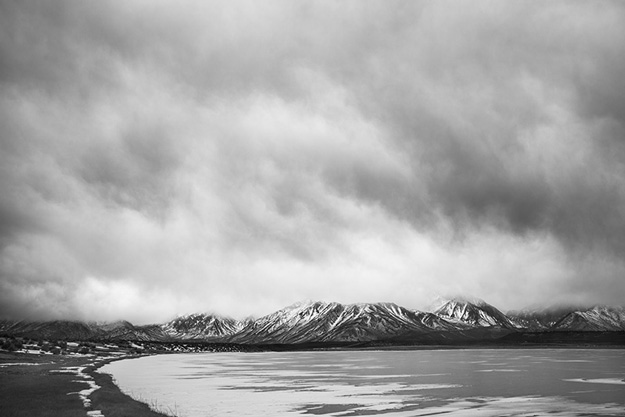
The Sony a7R provides a great platform for a wide variety of optics.
a7R with Minolta Maxxum 28mm f/2 on LA-EA4, ISO 50 f/11 1/2
Although, as expected, the Leica Wide Angle Tri-Elmar 16-18-21mm f/4 ASPH lens is probably close to ideal (ignoring the cost of admission) for a very wide angle on the a7R at the moment, there are some decent alternatives.
The Sony 10-18mm f/4, although intended for the APS-C sensor of the NEX series, actually covers the full-frame sensor fairly well at 15-16mm focal length. Distortion probably prohibits it from architectural use, and corners are far from perfect. Nevertheless, for landscape use with a little post-processing attention, this lens can yield very fine prints from the a7R. The OSS stabilization may help with the a7R’s sometimes-apparent shutter shake. Depending on subject matter and many other variables, one may get prints of comparable quality from this lens at 10-11mm on a NEX-7 versus at 15-16mm on an a7R.
For some particular subjects, aided by a lot of post work to taste, the Olympus Zuiko 16mm f/3.5 fisheye is a gem. Sharpness, depending on all the usual caveats, certainly rivals that of the WATE. It does exhibit some distortion, however.
Although its bulk and weight detract from the small and light concept of the a7R, the Sigma 8-16mm f/4.5-5.6 on the LA-EA4 adapter is super-wide and yielded some high-quality results. If you already own one for an Alpha-mount camera and can ignore its size, it is certainly worth using.
The M-Rokkor and Olympus Zuiko 28mm lenses both produced excellent images IF used at apertures of f/8 or f/11. The Olympus Zuiko 24mm f/2.8 is at least as good as these 28s, and may be among the best options available for the a7R. Nevertheless, these older lens designs are not up to the task of wide-aperture use unless only the central portion of the image needs to be critically sharp.
The Sony 24-70mm f/4 FE Vario-Tessar lens appears to be a good, and possibly very good, option IF you score one of the better copies. The zoom, stabilization, and relatively good image quality at wider apertures are definite positives that need to be balanced with not-quite-ideal corners at 24mm. One way of dealing with the corner deficiencies is to compose with the zoom at about 28-30mm, then set to 24mm, fire away, and crop later. So, maybe consider this lens on the a7R as a fine 28-70mm zoom lens on a 26-30mp sensor.
Although I don’t have a clue if a second crop option could be implemented via a firmware update, it could be highly useful to be able to crop away less of the frame than the large chop job of the APS-C crop. A few Nikon cameras (D800, D4, and D3s) have a 1.2x crop option, and I always liked the concept of Canon’s APS-H size sensor in the 1D series as a means of avoiding corner issues. A 1.2x crop mode in the menu of the a7R would save a little card memory and lessen the appearance of corner issues with a lot of adapted lenses that just don’t create a sufficiently-large image circle for the full-frame sensor (e.g., Sigma 19mm and 30mm). Of course, the full 24x36mm images can always be carved up after the fact. An in-camera 1.2x crop mode would just offer some minor convenience when using some non-native lenses.
The Sony a7R offers tremendous opportunity for using just about any interchangeable-mount lens ever made for 35mm and medium-format cameras on a 2013-state-of-the-art sensor. A few of the options in the wide-angle range have been described above. There is a vast array of creative possibilities to be explored with our ever-expanding tools.
Rick Kattelmann
May, 2014
Rick Kattelmann is a mostly-retired hydrologist who used photography to document research and water projects in mountain areas around the world. He has been an active amateur photographer for more than 45 years and has lived in the Sierra Nevada of California for the past 30 years. In retirement, he is finally making some use of his image archives and getting around to exhibiting and sharing photographs. A small sample of his photos from Asia can be found at Rick’s Website.
Published May 2, 2014
Updated: 2/26/15

Lorem ipsum dolor sit amet, consectetur adipiscing elit, sed do eiusmod tempor incididunt ut labore et dolore magna aliqua. Ut enim ad minim veniam, quis nostrud exercitation ullamco laboris nisi ut aliquip ex ea commodo consequat. Duis aute irure dolor in reprehenderit in voluptate velit esse cillum dolore eu fugiat nulla pariatur. Excepteur sint occaecat cupidatat non proident, sunt in culpa qui officia deserunt mollit anim id est laborum.
Lorem ipsum dolor sit amet, consectetur adipiscing elit, sed do eiusmod tempor incididunt ut labore et dolore magna aliqua. Ut enim ad minim veniam, quis nostrud exercitation ullamco laboris nisi ut aliquip ex ea commodo consequat. Duis aute irure dolor in reprehenderit in voluptate velit esse cillum dolore eu fugiat nulla pariatur. Excepteur sint occaecat cupidatat non proident, sunt in culpa qui officia deserunt mollit anim id est laborum.
Lorem ipsum dolor sit amet, consectetur adipiscing elit, sed do eiusmod tempor incididunt ut labore et dolore magna aliqua. Ut enim ad minim veniam, quis nostrud exercitation ullamco laboris nisi ut aliquip ex ea commodo consequat. Duis aute irure dolor in reprehenderit in voluptate velit esse cillum dolore eu fugiat nulla pariatur. Excepteur sint occaecat cupidatat non proident, sunt in culpa qui officia deserunt mollit anim id est laborum.
Lorem ipsum dolor sit amet, consectetur adipiscing elit, sed do eiusmod tempor incididunt ut labore et dolore magna aliqua. Ut enim ad minim veniam, quis nostrud exercitation ullamco laboris nisi ut aliquip ex ea commodo consequat. Duis aute irure dolor in reprehenderit in voluptate velit esse cillum dolore eu fugiat nulla pariatur. Excepteur sint occaecat cupidatat non proident, sunt in culpa qui officia deserunt mollit anim id est laborum.
You May Also Enjoy...
Digital in the Wilderness
By: Jean-François Maïon Is digital photography up to the challenges of extended outdoor adventures in harsh conditions? A year ago, I would probably have answered:
